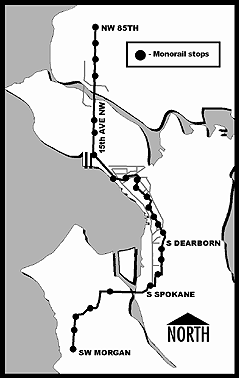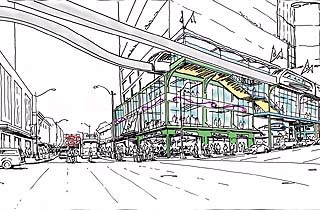
Surveys
DJC.COM
February 27, 2003
Monorail expected to spark new development
Seattle Monorail Project

McWilliams |
To meet our schedule, we have already brought together a premier management team, conducted city-wide community workshops, selected an internationally recognized design firm, and are actively issuing a series of contracts for support services, from surveying to environmental permitting.

From Ballard to West Seattle: Planned stations for the 14-mile Green Line.
|
For a recession-bound local economy, the project will generate over 2,100 jobs and make millions of dollars in direct investments over the five years of the Green Line’s construction. The project is working on a detailed environmental review which will allow decisions on the specific alignment and station locations within the Green Line corridor by November of this year.
In anticipation of the Green Line, the Seattle City Council passed a resolution in July 2002 to allow the use of city street rights of way to construct and operate the system.
As an elevated system, the Green Line runs primarily within existing public transportation corridors, avoiding costlier options such as tunneling while minimizing impacts to residents, businesses and surrounding properties. Low property acquisition costs, as well as the ability to fabricate a large portion of the facility off-site, reduce the overall Green Line price tag, offering a cost-effective way to increase mobility in Seattle.
The project’s focus on meeting budget and schedule commitments will also benefit from the design-build-operate-maintain (DBOM) contracting structure. DBOM will streamline the construction process, saving time and money.
By integrating engineering, design, construction and operations under a single point of responsibility, the project will eliminate many redundant, costly and conflicting processes.
The project recently released a draft request for qualifications (RFQ) for review and comment by the public and companies that may be interested in submitting proposals to design, build and operate the Green Line. The release of the draft RFQ was an additional effort by the project to provide maximum opportunity for competition, encourage creativity and new ideas, and maximize the opportunity of teams to form that meet the requirements of the plan.
The release of the final RFQ is scheduled for early March.
Although the project will be constructed mostly on public rights of way, some properties will need to be acquired for stations, the maintenance facility and limited stretches of the alignment.
In the event a property acquisition is required, the Seattle Monorail Project is committed to working with homeowners and businesses to ensure all property owners are treated fairly. The project will be establishing and submitting property acquisition procedures, consistent with state law, to the project’s board of directors for approval this spring. However, the project foresees the vast majority of property acquisitions occurring through negotiation.
In similar major transportation projects, the public is typically concerned about the possibility of devaluation of surrounding properties. However, studies of similar transit systems show significant increases in property values near transit stations.

Image courtesy of the Seattle Monorail Project Studies of similar transit systems show significant increases in property values near transit stations.
|
As a catalyst for transit-oriented development, the monorail is expected to spur development and increase property value within the Green Line neighborhood, from Ballard to West Seattle. The convenience of transit access is shown to attract residents and retail businesses, increase pedestrian activity and inter-neighborhood connectivity.
In 18 months, the Seattle Monorail Project will issue a notice to begin construction on its Green Line, a system that will tie together some of the city’s most important destinations such as Key Arena, Belltown, downtown, Pike Place Market, King Street Station, Safeco Field and Seahawks Stadium. The project’s success will be measured in the satisfaction of its riders and surrounding neighborhoods.
The monorail project has established a standard to minimize right of way impacts through open and transparent decision-making, a shared sense of responsibility among the project team and a commitment towards accountability that will lead the development of a future city-wide monorail system.
Joe McWilliams is the director of right of way assembly for the Seattle Monorail Project. He has 22 years of commercial real estate experience, including stints as managing director for Washington state at Cushman and Wakefield, and vice president of asset management at Wright Runstad and Co.
Other Stories:
- Seattle’s economy: Out of sync?
- Insurance industry weathers a ‘perfect storm’
- Marketing homes during war
- Creating suburban living in the city
- Young blood takes on a challenging market
- Mortgages and technology: A Catch 22
- The moisture vs. energy code balancing act
- Colleges face big real estate challenges
- Cooking up a new business? Think incubator
- New laws needed to fight insurance crisis
- In Bellevue, holes aren’t the whole story
- TODs: Look beyond the physical characteristics
- Affordable housing still GMA challenge
- Third time’s the charm for Lakewood retail
Copyright ©2009 Seattle Daily Journal and DJC.COM.
Comments? Questions? Contact us.